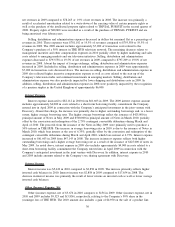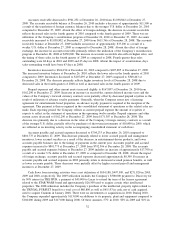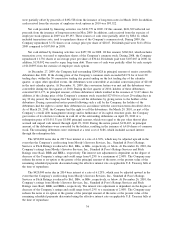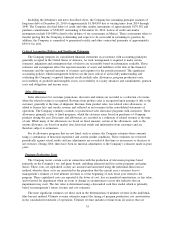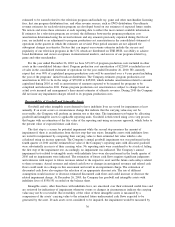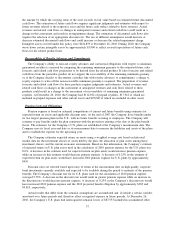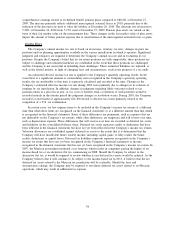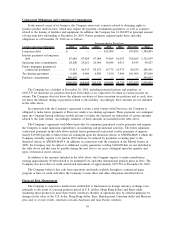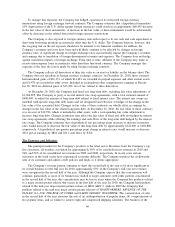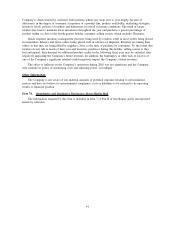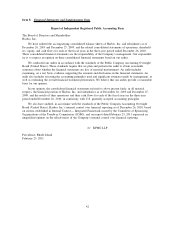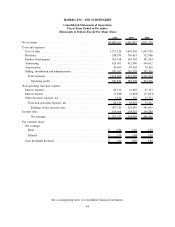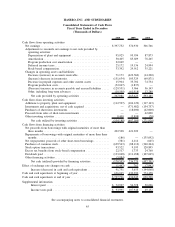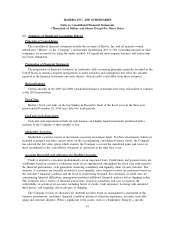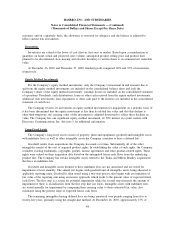Hasbro 2010 Annual Report Download - page 50
Download and view the complete annual report
Please find page 50 of the 2010 Hasbro annual report below. You can navigate through the pages in the report by either clicking on the pages listed below, or by using the keyword search tool below to find specific information within the annual report.
To manage this exposure, the Company has hedged a portion of its forecasted foreign currency
transactions using foreign exchange forward contracts. The Company estimates that a hypothetical immediate
10% depreciation of the U.S. dollar against foreign currencies could result in an approximate $68,455 decrease
in the fair value of these instruments. A decrease in the fair value of these instruments would be substantially
offset by decreases in the related forecasted foreign currency transactions.
The Company is also exposed to foreign currency risk with respect to its net cash and cash equivalents or
short-term borrowing positions in currencies other than the U.S. dollar. The Company believes, however, that
the on-going risk on the net exposure should not be material to its financial condition. In addition, the
Company’s revenues and costs have been and will likely continue to be affected by changes in foreign
currency rates. A significant change in foreign exchange rates can materially impact the Company’s revenues
and earnings due to translation of foreign-denominated revenues and expenses. The Company does not hedge
against translation impacts of foreign exchange. From time to time, affiliates of the Company may make or
receive intercompany loans in currencies other than their functional currency. The Company manages this
exposure at the time the loan is made by using foreign exchange contracts.
The Company reflects all derivatives at their fair value as an asset or liability on the balance sheet. The
Company does not speculate in foreign currency exchange contracts. At December 26, 2010, these contracts
had unrealized gains of $16,151, of which $14,681 are recorded in prepaid expenses and other current assets
and $1,470 are recorded in other assets. Included in accumulated other comprehensive earnings at Decem-
ber 26, 2010 are deferred gains of $15,432, net of tax, related to these derivatives.
At December 26, 2010, the Company had fixed rate long-term debt, excluding fair value adjustments, of
$1,384,895. The Company is party to several interest rate swap agreements, with a total notional amount of
$400,000, to adjust the amount of long-term debt subject to fixed interest rates. The interest rate swaps are
matched with specific long-term debt issues and are designated and effective as hedges of the change in the
fair value of the associated debt. Changes in fair value of these contracts are wholly offset in earnings by
changes in the fair value of the related long-term debt. At December 26, 2010, the fair value of these contracts
was an asset of $12,786, which is included in other assets, with a corresponding fair value adjustment to
increase long-term debt. Changes in interest rates affect the fair value of fixed rate debt not hedged by interest
rate swap agreements while affecting the earnings and cash flows of the long-term debt hedged by the interest
rate swaps. The Company estimates that a hypothetical one percentage point decrease or increase in interest
rates would increase or decrease the fair value of this long-term debt by approximately $122,000 or $104,800,
respectively. A hypothetical one-quarter percentage point change in interest rates would increase or decrease
2011 pretax earnings by $882 and 2011 cash flows by $764.
The Economy and Inflation
The principal market for the Company’s products is the retail sector. Revenues from the Company’s top
five customers, all retailers, accounted for approximately 50% of its consolidated net revenues in 2010 and
54% and 52% of its consolidated net revenues in 2009 and 2008, respectively. In recent years certain
customers in the retail sector have experienced economic difficulty. The Company monitors the creditworthi-
ness of its customers and adjusts credit policies and limits as it deems appropriate.
The Company’s revenue pattern continues to show the second half of the year to be more significant to
its overall business for the full year. In 2010, approximately 65% of the Company’s full year net revenues
were recognized in the second half of the year. Although the Company expects that this concentration will
continue, particularly as more of its business has shifted to larger customers with order patterns concentrated
in the second half of the year, this concentration may be less in years where the Company has products related
to a major motion picture release that occurs in the first half of the year. In 2010, the Company had products
related to the mid-year major motion picture release of IRON MAN 2, while in 2009 the Company had
products related to the mid-year major motion picture releases of TRANSFORMERS: REVENGE OF THE
FALLEN,G.I. JOE: THE RISE OF COBRA and X-MEN ORIGINS: WOLVERINE. The concentration of sales
in the second half of the year increases the risk of (a) underproduction of popular items, (b) overproduction of
less popular items, and (c) failure to achieve tight and compressed shipping schedules. The business of the
40


